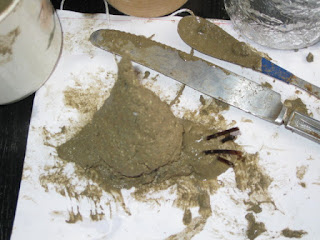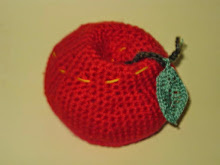The concentric circles might be the shape as if seen from the base up the cone. I had been mistakenly thinking of the "fibonacci ripples" from my blog posts of April 2011, but the numbers are different there. I had then discovered for myself a number of equations, eg the radius of a circle with circumference F(n) eg 21 is almost 1/10 of F(n+1) ie 3.4 units. True all along;
Moreover the "almost", the incremental difference, when dividing the larger by the smaller, is phi, 1.618; the Golden Rule, etc.
A bit of a mess! Experiment to see how it takes a layer of roman hydraulic cement. Fine clay dust plus fine grey cement, equal quantities, with minimum water to create a kind of gel. Apply with knife to dry crochet cone, or it might work better with wet surface.
Make body by squishing dacron cushion filling material in cement mix, or you can use wool or whatever to give body. Sticks for eyes. This is a very rough model!
Finished model. The next efforts might be a little more careful.
One notes that grey cement has a high proportion of fly ash from blast furnaces burning coal. They will do anything to flog waste materials especially this which is in supermassive abundance in our civilised world. Care about the fact that there is a high level of toxic heavy metals in fly ash which might harm plants, soil micro-organisms, insects, birds et al. Next time I will use white cement which I think is only burnt lime. The Romans used Vesuvius ash and fine clay, and their aqueducts still stand to this day.
******************************************************
My secret wish is to make a DIORMA of crocheted seashells with and without moulded bodies, with hyperbolic green seaweeds, some Nautilus, maybe some Octopi (8 and 144, divisible by 8), plus mobiles of mermaids, an example has been already drawn by a young lady with a confident hand:-

------------------------------------
I heard a wonderful interview on LNL, Radio National, some time ago. He was fascinated by mathematics when he was young. He remembered watching a caterpillar walking in its own peculiar way. Years later he MADE one, sculpted in wood and with a MOTOR. You would be amazed to see the giant sculptures he's made, one like a huge amoeba, with motors to move the body.
------------------------------------





No comments:
Post a Comment